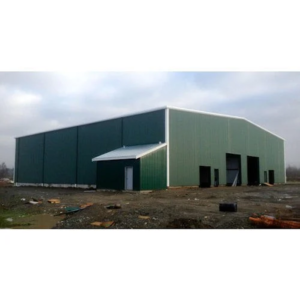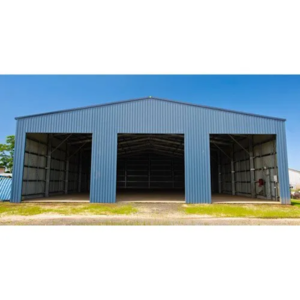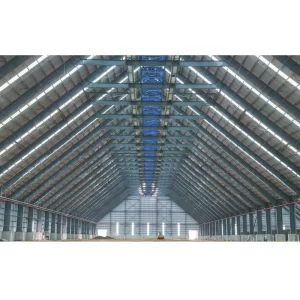Prefabricated Industrial Buildings
Prefabricated Industrial Buildings: A Complete Guide to Modular Construction & Benefits
Introduction
Prefabricated industrial buildings are revolutionizing the construction industry with cost-effective, durable, and time-efficient solutions for warehouses, factories, storage facilities, and commercial spaces. These structures are built off-site in controlled environments and then assembled on-site, reducing construction time and labor costs.
As industries seek sustainable, flexible, and customizable building solutions, prefabricated buildings have become a preferred choice due to their durability, design versatility, and efficiency.
In this comprehensive guide, we will cover:
-
What are prefabricated industrial buildings?
-
Types of prefab industrial buildings
-
Advantages and applications
-
Key materials and construction process
-
Sustainability and energy efficiency
-
Installation and maintenance tips
-
Frequently Asked Questions (FAQs)
What are Prefabricated Industrial Buildings?
Prefabricated industrial buildings, also known as modular industrial buildings, are structures manufactured in factory settings and later transported to the site for assembly. These buildings are made using steel, aluminum, concrete, and composite materials, ensuring durability and strength.
Unlike traditional construction, which is time-consuming and labor-intensive, prefab buildings offer fast, cost-effective, and eco-friendly solutions without compromising quality.
Key Features of Prefabricated Industrial Buildings
✔ Quick assembly and installation
✔ Customizable design for different industries
✔ Cost-effective and budget-friendly
✔ Sustainable and energy-efficient
✔ Durable and weather-resistant
✔ Minimal site disruption during construction
Types of Prefabricated Industrial Buildings
1. Pre-Engineered Buildings (PEB)
-
Designed for factories, warehouses, and commercial spaces.
-
Built using steel frames, metal panels, and insulated roofing.
-
Offers high strength, fire resistance, and cost efficiency.
2. Modular Industrial Buildings
-
Composed of pre-built sections that are transported and assembled on-site.
-
Used for office spaces, portable manufacturing units, and workshops.
-
Highly customizable and relocatable.
3. Steel Prefab Industrial Buildings
-
Made from heavy-duty steel, ensuring longevity and stability.
-
Used for logistics centers, storage units, and power plants.
-
Resistant to corrosion, extreme weather, and seismic activity.
4. Prefabricated Concrete Structures
-
Utilized in large industrial complexes, bridges, and tunnels.
-
Offers high thermal efficiency and sound insulation.
-
Can withstand harsh environmental conditions.
5. Hybrid Prefabricated Buildings
-
Combination of steel, wood, and concrete for better efficiency.
-
Designed for custom industrial projects and commercial offices.
-
Provides architectural flexibility and enhanced energy efficiency.
Benefits of Prefabricated Industrial Buildings
1. Faster Construction & Installation
-
Prefab buildings reduce construction time by 50% or more.
-
Off-site manufacturing minimizes weather-related delays.
2. Cost-Effective & Budget-Friendly
-
Lower labor and material costs compared to conventional buildings.
-
Reduced maintenance expenses due to durable materials.
3. Customization & Flexibility
-
Available in various sizes, shapes, and layouts.
-
Can be expanded or modified to meet industry demands.
4. Eco-Friendly & Sustainable
-
Prefab construction reduces waste and carbon footprint.
-
Uses recyclable materials like steel and concrete.
5. High Durability & Strength
-
Withstands extreme weather conditions, earthquakes, and corrosion.
-
Designed for long-term industrial use with minimal wear and tear.
6. Minimal Site Disruption
-
Off-site manufacturing keeps on-site activities minimal.
-
Suitable for urban and industrial areas with space constraints.
Industries That Benefit from Prefabricated Buildings
✅ Manufacturing Plants – Quick installation for large-scale production.
✅ Warehouses & Storage Units – High-strength steel structures for goods storage.
✅ Logistics & Distribution Centers – Customizable layouts for seamless operations.
✅ Automobile & Aviation Industry – Spacious prefab hangars and factories.
✅ Commercial & Office Buildings – Modular offices with flexible designs.
✅ Power Plants & Energy Sector – Heavy-duty prefab structures for power generation.
✅ Agriculture & Food Processing Units – Hygienic, weatherproof buildings.
Materials Used in Prefabricated Industrial Buildings
🔹 Steel – High-strength, corrosion-resistant, and long-lasting.
🔹 Aluminum – Lightweight and durable for modular structures.
🔹 Concrete Panels – Provides insulation and fire resistance.
🔹 Sandwich Panels – Offers energy efficiency and climate control.
🔹 Glass & Polycarbonate Sheets – Enhances aesthetics and natural lighting.
Installation & Maintenance Tips
Installation Guidelines
✅ Conduct site preparation and leveling before assembly.
✅ Use skilled professionals for safe and efficient installation.
✅ Follow manufacturer guidelines for structure and load-bearing capacity.
✅ Ensure proper anchoring and fastening for stability.
✅ Perform quality checks on insulation and sealing.
Maintenance Tips
✅ Regularly inspect for rust, corrosion, and structural damage.
✅ Clean and repaint metal surfaces for longevity.
✅ Check electrical and plumbing systems for wear and tear.
✅ Ensure proper drainage to prevent water accumulation.
✅ Replace damaged panels or roofing for safety and insulation.
Frequently Asked Questions (FAQs)
1. What is the lifespan of a prefabricated industrial building?
Most prefab buildings last 30-50 years or more, depending on materials and maintenance.
2. How long does it take to construct a prefab industrial building?
Construction time varies but is 50% faster than traditional buildings, with some projects completed in weeks instead of months.
3. Are prefab buildings more cost-effective than traditional buildings?
Yes! Prefab buildings save 20-40% in costs due to reduced labor, materials, and maintenance expenses.
4. Can prefab industrial buildings be customized?
Absolutely! Prefabricated buildings come in various sizes, designs, and materials to meet industry-specific needs.
5. Are prefab industrial buildings earthquake-resistant?
Yes, prefab structures are designed with seismic-resistant materials and reinforcements.
6. Do prefab buildings require foundations?
Yes, but foundation requirements depend on building size, soil conditions, and load capacity.
7. Are prefabricated buildings energy-efficient?
Yes! They incorporate insulated panels, energy-efficient lighting, and solar power integration.
8. Can prefab buildings be relocated?
Some modular prefab buildings can be disassembled and relocated based on project needs.
9. Are prefab buildings suitable for extreme weather conditions?
Yes, they are engineered to withstand heavy snow, high winds, and extreme temperatures.
10. What permits are required for prefabricated industrial buildings?
Building codes vary by location. Always check local zoning laws and construction permits before installation.
Final Thoughts
Prefabricated industrial buildings are the future of construction, offering affordable, sustainable, and durable solutions for various industries. With quick installation, customizable designs, and minimal environmental impact, these buildings provide the perfect balance of efficiency and innovation.
If you’re looking for a reliable and cost-effective industrial building solution, explore the latest prefabricated structures today! 🏗️🏭




